Analyzing the Effect of Bacteria on the Oral Immune System Dynamics
VerifiedAdded on 2023/05/31
|8
|1802
|284
Report
AI Summary
This report examines the effects of various bacteria, including Streptococcus mutans, Porphyromonas gingivalis, and probiotics, on the oral immune system. It details how bacteria like S. mutans contribute to tooth decay by producing acids that erode enamel, while P. gingivalis and Treponema denticola can lead to periodontal disease, weakening the immune system and potentially causing systemic issues such as kidney disease, rheumatoid arthritis, and cardiovascular problems. The report also highlights the beneficial roles of probiotics like Streptococcus salivarius K12 in promoting oral health by stimulating saliva production, preventing plaque formation, and inhibiting harmful bacteria, ultimately strengthening the oral immune system. The balance between harmful and beneficial bacteria is crucial for maintaining overall oral health and preventing related systemic diseases.

SURNAME 1
Surname
Instructor
Course
Date
Effect of Bacteria on Oral Immune System
Table of content
Introduction……………………………………………………………..2
Discussion……………………………………………………………….3
Conclusion………………………………………………………………6
References………………………………………………………………7
Surname
Instructor
Course
Date
Effect of Bacteria on Oral Immune System
Table of content
Introduction……………………………………………………………..2
Discussion……………………………………………………………….3
Conclusion………………………………………………………………6
References………………………………………………………………7
Paraphrase This Document
Need a fresh take? Get an instant paraphrase of this document with our AI Paraphraser
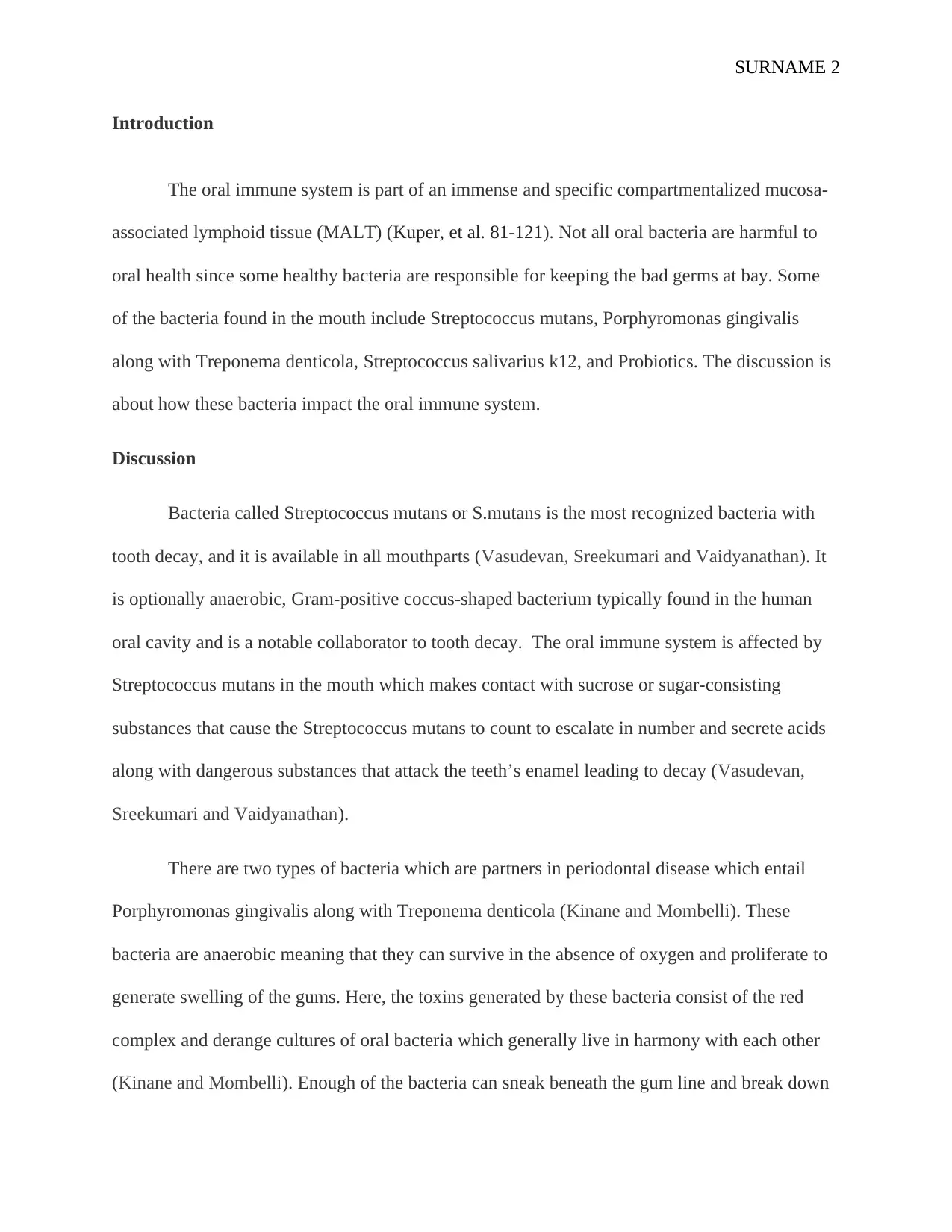
SURNAME 2
Introduction
The oral immune system is part of an immense and specific compartmentalized mucosa-
associated lymphoid tissue (MALT) (Kuper, et al. 81-121). Not all oral bacteria are harmful to
oral health since some healthy bacteria are responsible for keeping the bad germs at bay. Some
of the bacteria found in the mouth include Streptococcus mutans, Porphyromonas gingivalis
along with Treponema denticola, Streptococcus salivarius k12, and Probiotics. The discussion is
about how these bacteria impact the oral immune system.
Discussion
Bacteria called Streptococcus mutans or S.mutans is the most recognized bacteria with
tooth decay, and it is available in all mouthparts (Vasudevan, Sreekumari and Vaidyanathan). It
is optionally anaerobic, Gram-positive coccus-shaped bacterium typically found in the human
oral cavity and is a notable collaborator to tooth decay. The oral immune system is affected by
Streptococcus mutans in the mouth which makes contact with sucrose or sugar-consisting
substances that cause the Streptococcus mutans to count to escalate in number and secrete acids
along with dangerous substances that attack the teeth’s enamel leading to decay (Vasudevan,
Sreekumari and Vaidyanathan).
There are two types of bacteria which are partners in periodontal disease which entail
Porphyromonas gingivalis along with Treponema denticola (Kinane and Mombelli). These
bacteria are anaerobic meaning that they can survive in the absence of oxygen and proliferate to
generate swelling of the gums. Here, the toxins generated by these bacteria consist of the red
complex and derange cultures of oral bacteria which generally live in harmony with each other
(Kinane and Mombelli). Enough of the bacteria can sneak beneath the gum line and break down
Introduction
The oral immune system is part of an immense and specific compartmentalized mucosa-
associated lymphoid tissue (MALT) (Kuper, et al. 81-121). Not all oral bacteria are harmful to
oral health since some healthy bacteria are responsible for keeping the bad germs at bay. Some
of the bacteria found in the mouth include Streptococcus mutans, Porphyromonas gingivalis
along with Treponema denticola, Streptococcus salivarius k12, and Probiotics. The discussion is
about how these bacteria impact the oral immune system.
Discussion
Bacteria called Streptococcus mutans or S.mutans is the most recognized bacteria with
tooth decay, and it is available in all mouthparts (Vasudevan, Sreekumari and Vaidyanathan). It
is optionally anaerobic, Gram-positive coccus-shaped bacterium typically found in the human
oral cavity and is a notable collaborator to tooth decay. The oral immune system is affected by
Streptococcus mutans in the mouth which makes contact with sucrose or sugar-consisting
substances that cause the Streptococcus mutans to count to escalate in number and secrete acids
along with dangerous substances that attack the teeth’s enamel leading to decay (Vasudevan,
Sreekumari and Vaidyanathan).
There are two types of bacteria which are partners in periodontal disease which entail
Porphyromonas gingivalis along with Treponema denticola (Kinane and Mombelli). These
bacteria are anaerobic meaning that they can survive in the absence of oxygen and proliferate to
generate swelling of the gums. Here, the toxins generated by these bacteria consist of the red
complex and derange cultures of oral bacteria which generally live in harmony with each other
(Kinane and Mombelli). Enough of the bacteria can sneak beneath the gum line and break down
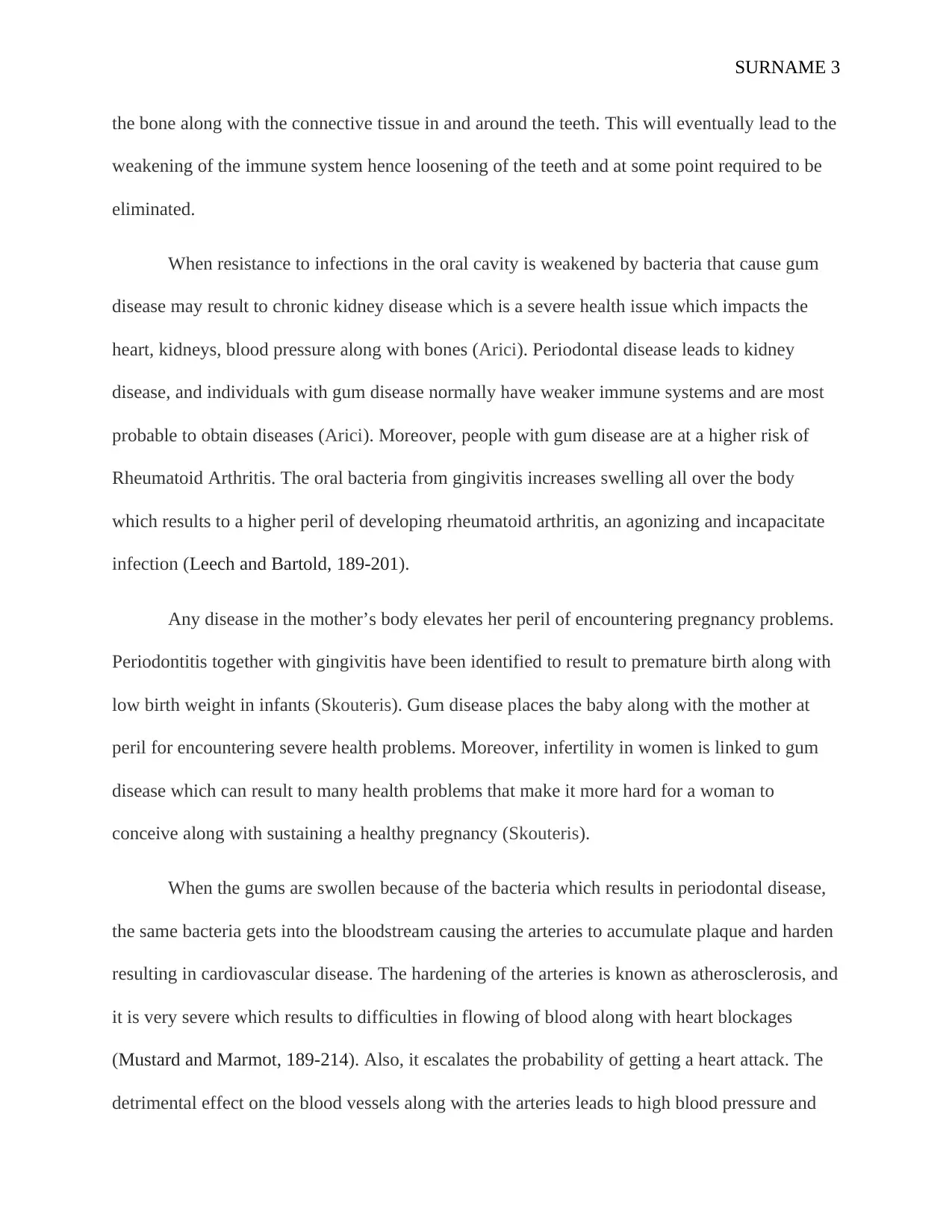
SURNAME 3
the bone along with the connective tissue in and around the teeth. This will eventually lead to the
weakening of the immune system hence loosening of the teeth and at some point required to be
eliminated.
When resistance to infections in the oral cavity is weakened by bacteria that cause gum
disease may result to chronic kidney disease which is a severe health issue which impacts the
heart, kidneys, blood pressure along with bones (Arici). Periodontal disease leads to kidney
disease, and individuals with gum disease normally have weaker immune systems and are most
probable to obtain diseases (Arici). Moreover, people with gum disease are at a higher risk of
Rheumatoid Arthritis. The oral bacteria from gingivitis increases swelling all over the body
which results to a higher peril of developing rheumatoid arthritis, an agonizing and incapacitate
infection (Leech and Bartold, 189-201).
Any disease in the mother’s body elevates her peril of encountering pregnancy problems.
Periodontitis together with gingivitis have been identified to result to premature birth along with
low birth weight in infants (Skouteris). Gum disease places the baby along with the mother at
peril for encountering severe health problems. Moreover, infertility in women is linked to gum
disease which can result to many health problems that make it more hard for a woman to
conceive along with sustaining a healthy pregnancy (Skouteris).
When the gums are swollen because of the bacteria which results in periodontal disease,
the same bacteria gets into the bloodstream causing the arteries to accumulate plaque and harden
resulting in cardiovascular disease. The hardening of the arteries is known as atherosclerosis, and
it is very severe which results to difficulties in flowing of blood along with heart blockages
(Mustard and Marmot, 189-214). Also, it escalates the probability of getting a heart attack. The
detrimental effect on the blood vessels along with the arteries leads to high blood pressure and
the bone along with the connective tissue in and around the teeth. This will eventually lead to the
weakening of the immune system hence loosening of the teeth and at some point required to be
eliminated.
When resistance to infections in the oral cavity is weakened by bacteria that cause gum
disease may result to chronic kidney disease which is a severe health issue which impacts the
heart, kidneys, blood pressure along with bones (Arici). Periodontal disease leads to kidney
disease, and individuals with gum disease normally have weaker immune systems and are most
probable to obtain diseases (Arici). Moreover, people with gum disease are at a higher risk of
Rheumatoid Arthritis. The oral bacteria from gingivitis increases swelling all over the body
which results to a higher peril of developing rheumatoid arthritis, an agonizing and incapacitate
infection (Leech and Bartold, 189-201).
Any disease in the mother’s body elevates her peril of encountering pregnancy problems.
Periodontitis together with gingivitis have been identified to result to premature birth along with
low birth weight in infants (Skouteris). Gum disease places the baby along with the mother at
peril for encountering severe health problems. Moreover, infertility in women is linked to gum
disease which can result to many health problems that make it more hard for a woman to
conceive along with sustaining a healthy pregnancy (Skouteris).
When the gums are swollen because of the bacteria which results in periodontal disease,
the same bacteria gets into the bloodstream causing the arteries to accumulate plaque and harden
resulting in cardiovascular disease. The hardening of the arteries is known as atherosclerosis, and
it is very severe which results to difficulties in flowing of blood along with heart blockages
(Mustard and Marmot, 189-214). Also, it escalates the probability of getting a heart attack. The
detrimental effect on the blood vessels along with the arteries leads to high blood pressure and
⊘ This is a preview!⊘
Do you want full access?
Subscribe today to unlock all pages.

Trusted by 1+ million students worldwide
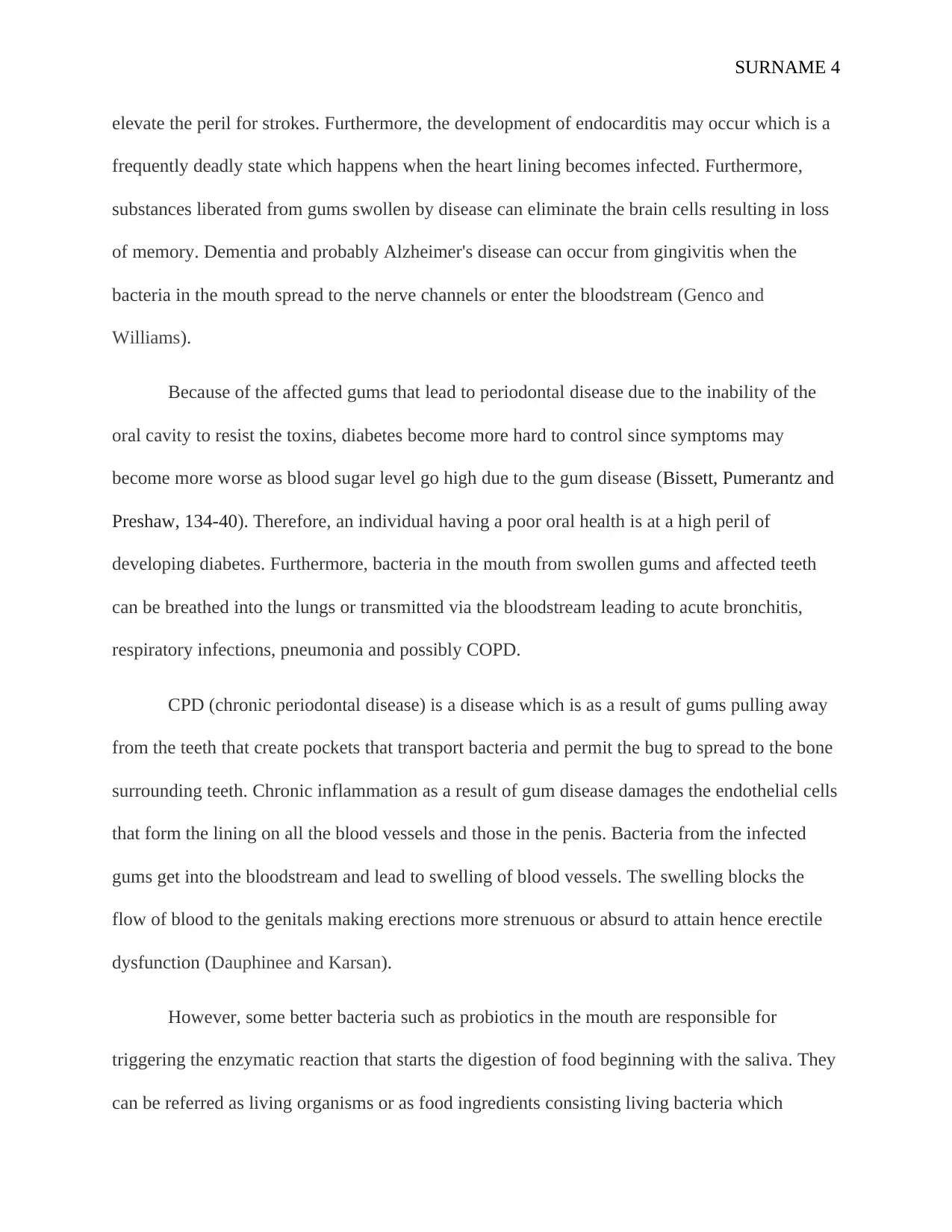
SURNAME 4
elevate the peril for strokes. Furthermore, the development of endocarditis may occur which is a
frequently deadly state which happens when the heart lining becomes infected. Furthermore,
substances liberated from gums swollen by disease can eliminate the brain cells resulting in loss
of memory. Dementia and probably Alzheimer's disease can occur from gingivitis when the
bacteria in the mouth spread to the nerve channels or enter the bloodstream (Genco and
Williams).
Because of the affected gums that lead to periodontal disease due to the inability of the
oral cavity to resist the toxins, diabetes become more hard to control since symptoms may
become more worse as blood sugar level go high due to the gum disease (Bissett, Pumerantz and
Preshaw, 134-40). Therefore, an individual having a poor oral health is at a high peril of
developing diabetes. Furthermore, bacteria in the mouth from swollen gums and affected teeth
can be breathed into the lungs or transmitted via the bloodstream leading to acute bronchitis,
respiratory infections, pneumonia and possibly COPD.
CPD (chronic periodontal disease) is a disease which is as a result of gums pulling away
from the teeth that create pockets that transport bacteria and permit the bug to spread to the bone
surrounding teeth. Chronic inflammation as a result of gum disease damages the endothelial cells
that form the lining on all the blood vessels and those in the penis. Bacteria from the infected
gums get into the bloodstream and lead to swelling of blood vessels. The swelling blocks the
flow of blood to the genitals making erections more strenuous or absurd to attain hence erectile
dysfunction (Dauphinee and Karsan).
However, some better bacteria such as probiotics in the mouth are responsible for
triggering the enzymatic reaction that starts the digestion of food beginning with the saliva. They
can be referred as living organisms or as food ingredients consisting living bacteria which
elevate the peril for strokes. Furthermore, the development of endocarditis may occur which is a
frequently deadly state which happens when the heart lining becomes infected. Furthermore,
substances liberated from gums swollen by disease can eliminate the brain cells resulting in loss
of memory. Dementia and probably Alzheimer's disease can occur from gingivitis when the
bacteria in the mouth spread to the nerve channels or enter the bloodstream (Genco and
Williams).
Because of the affected gums that lead to periodontal disease due to the inability of the
oral cavity to resist the toxins, diabetes become more hard to control since symptoms may
become more worse as blood sugar level go high due to the gum disease (Bissett, Pumerantz and
Preshaw, 134-40). Therefore, an individual having a poor oral health is at a high peril of
developing diabetes. Furthermore, bacteria in the mouth from swollen gums and affected teeth
can be breathed into the lungs or transmitted via the bloodstream leading to acute bronchitis,
respiratory infections, pneumonia and possibly COPD.
CPD (chronic periodontal disease) is a disease which is as a result of gums pulling away
from the teeth that create pockets that transport bacteria and permit the bug to spread to the bone
surrounding teeth. Chronic inflammation as a result of gum disease damages the endothelial cells
that form the lining on all the blood vessels and those in the penis. Bacteria from the infected
gums get into the bloodstream and lead to swelling of blood vessels. The swelling blocks the
flow of blood to the genitals making erections more strenuous or absurd to attain hence erectile
dysfunction (Dauphinee and Karsan).
However, some better bacteria such as probiotics in the mouth are responsible for
triggering the enzymatic reaction that starts the digestion of food beginning with the saliva. They
can be referred as living organisms or as food ingredients consisting living bacteria which
Paraphrase This Document
Need a fresh take? Get an instant paraphrase of this document with our AI Paraphraser
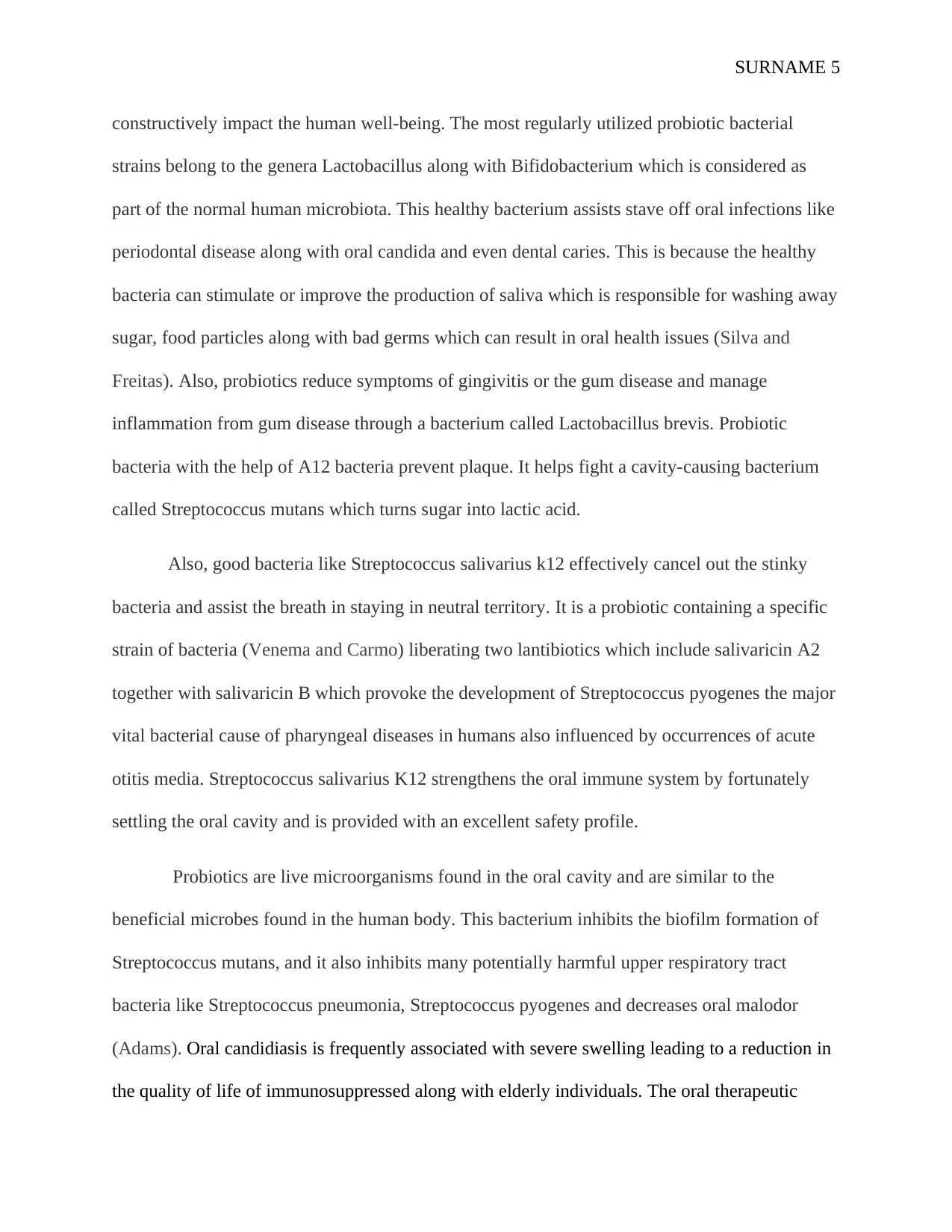
SURNAME 5
constructively impact the human well-being. The most regularly utilized probiotic bacterial
strains belong to the genera Lactobacillus along with Bifidobacterium which is considered as
part of the normal human microbiota. This healthy bacterium assists stave off oral infections like
periodontal disease along with oral candida and even dental caries. This is because the healthy
bacteria can stimulate or improve the production of saliva which is responsible for washing away
sugar, food particles along with bad germs which can result in oral health issues (Silva and
Freitas). Also, probiotics reduce symptoms of gingivitis or the gum disease and manage
inflammation from gum disease through a bacterium called Lactobacillus brevis. Probiotic
bacteria with the help of A12 bacteria prevent plaque. It helps fight a cavity-causing bacterium
called Streptococcus mutans which turns sugar into lactic acid.
Also, good bacteria like Streptococcus salivarius k12 effectively cancel out the stinky
bacteria and assist the breath in staying in neutral territory. It is a probiotic containing a specific
strain of bacteria (Venema and Carmo) liberating two lantibiotics which include salivaricin A2
together with salivaricin B which provoke the development of Streptococcus pyogenes the major
vital bacterial cause of pharyngeal diseases in humans also influenced by occurrences of acute
otitis media. Streptococcus salivarius K12 strengthens the oral immune system by fortunately
settling the oral cavity and is provided with an excellent safety profile.
Probiotics are live microorganisms found in the oral cavity and are similar to the
beneficial microbes found in the human body. This bacterium inhibits the biofilm formation of
Streptococcus mutans, and it also inhibits many potentially harmful upper respiratory tract
bacteria like Streptococcus pneumonia, Streptococcus pyogenes and decreases oral malodor
(Adams). Oral candidiasis is frequently associated with severe swelling leading to a reduction in
the quality of life of immunosuppressed along with elderly individuals. The oral therapeutic
constructively impact the human well-being. The most regularly utilized probiotic bacterial
strains belong to the genera Lactobacillus along with Bifidobacterium which is considered as
part of the normal human microbiota. This healthy bacterium assists stave off oral infections like
periodontal disease along with oral candida and even dental caries. This is because the healthy
bacteria can stimulate or improve the production of saliva which is responsible for washing away
sugar, food particles along with bad germs which can result in oral health issues (Silva and
Freitas). Also, probiotics reduce symptoms of gingivitis or the gum disease and manage
inflammation from gum disease through a bacterium called Lactobacillus brevis. Probiotic
bacteria with the help of A12 bacteria prevent plaque. It helps fight a cavity-causing bacterium
called Streptococcus mutans which turns sugar into lactic acid.
Also, good bacteria like Streptococcus salivarius k12 effectively cancel out the stinky
bacteria and assist the breath in staying in neutral territory. It is a probiotic containing a specific
strain of bacteria (Venema and Carmo) liberating two lantibiotics which include salivaricin A2
together with salivaricin B which provoke the development of Streptococcus pyogenes the major
vital bacterial cause of pharyngeal diseases in humans also influenced by occurrences of acute
otitis media. Streptococcus salivarius K12 strengthens the oral immune system by fortunately
settling the oral cavity and is provided with an excellent safety profile.
Probiotics are live microorganisms found in the oral cavity and are similar to the
beneficial microbes found in the human body. This bacterium inhibits the biofilm formation of
Streptococcus mutans, and it also inhibits many potentially harmful upper respiratory tract
bacteria like Streptococcus pneumonia, Streptococcus pyogenes and decreases oral malodor
(Adams). Oral candidiasis is frequently associated with severe swelling leading to a reduction in
the quality of life of immunosuppressed along with elderly individuals. The oral therapeutic
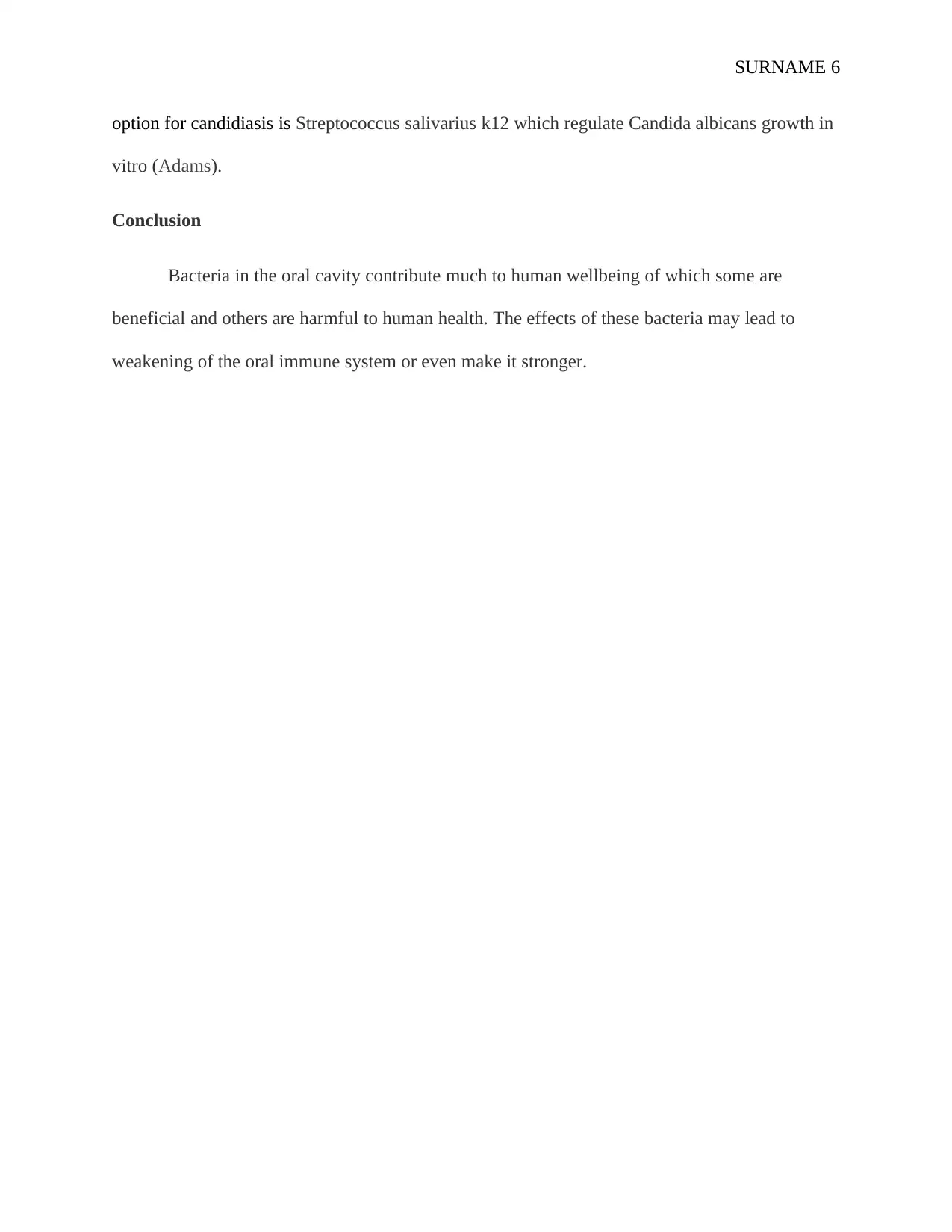
SURNAME 6
option for candidiasis is Streptococcus salivarius k12 which regulate Candida albicans growth in
vitro (Adams).
Conclusion
Bacteria in the oral cavity contribute much to human wellbeing of which some are
beneficial and others are harmful to human health. The effects of these bacteria may lead to
weakening of the oral immune system or even make it stronger.
option for candidiasis is Streptococcus salivarius k12 which regulate Candida albicans growth in
vitro (Adams).
Conclusion
Bacteria in the oral cavity contribute much to human wellbeing of which some are
beneficial and others are harmful to human health. The effects of these bacteria may lead to
weakening of the oral immune system or even make it stronger.
⊘ This is a preview!⊘
Do you want full access?
Subscribe today to unlock all pages.

Trusted by 1+ million students worldwide

SURNAME 7
Works cited
Adams, Casey. Oral probiotics : the newest way to prevent infection, boost the immune system
and fight disease. Wilmington, Delaware: Sacred Earth Pub, 2010. Print.
Arici, Mustafa. Management of chronic kidney disease : a clinician's guide. Berlin: Springer,
2014. Print.
Bissett, S. M., A. S. Pumerantz, and P. M. Preshaw. "Periodontal disease and diabetes." Journal
of Diabetes Nursing 19 (2015): 134-40.
Dauphinee, Shauna M., and Aly Karsan. Endothelial dysfunction and inflammation. Basel:
Birkhäuser, 2010. Print.
Genco, Robert J., and Ray C. Williams. Periodontal disease and overall health : a clinician's
guide. Yardley, Pa: Professional Audience Communications, 2010. Print.
Kinane, Denis F., and Andrea Mombelli. Periodontal disease. Basel: Karger, 2012. Print.
Kuper, Christine Frieke, et al. "Mucosa-Associated Lymphoid Tissues." Immunopathology in
Toxicology and Drug Development. Humana Press, Cham, 2017. 81-121.
Leech, Michelle T., and P. M. Bartold. "The association between rheumatoid arthritis and
periodontitis." Best Practice & Research Clinical Rheumatology 29.2 (2015): 189-201.
Mustard, J. F., and M. G. Marmot. "Coronary Heart Disease from a Population
Perspective." Why are Some People Healthy and Others Not?. Routledge, 2017. 189-214.
Silva, and Ana C. Freitas. Probiotic bacteria : fundamentals, therapy and technological aspects.
Boca Raton Singapore: CRC Press Pan Stanford Publishing, 2014. Print.
Skouteris, Christos A. Dental management of the pregnant patient. Hoboken, NJ: John Wiley &
Sons, Inc, 2018. Print.
Works cited
Adams, Casey. Oral probiotics : the newest way to prevent infection, boost the immune system
and fight disease. Wilmington, Delaware: Sacred Earth Pub, 2010. Print.
Arici, Mustafa. Management of chronic kidney disease : a clinician's guide. Berlin: Springer,
2014. Print.
Bissett, S. M., A. S. Pumerantz, and P. M. Preshaw. "Periodontal disease and diabetes." Journal
of Diabetes Nursing 19 (2015): 134-40.
Dauphinee, Shauna M., and Aly Karsan. Endothelial dysfunction and inflammation. Basel:
Birkhäuser, 2010. Print.
Genco, Robert J., and Ray C. Williams. Periodontal disease and overall health : a clinician's
guide. Yardley, Pa: Professional Audience Communications, 2010. Print.
Kinane, Denis F., and Andrea Mombelli. Periodontal disease. Basel: Karger, 2012. Print.
Kuper, Christine Frieke, et al. "Mucosa-Associated Lymphoid Tissues." Immunopathology in
Toxicology and Drug Development. Humana Press, Cham, 2017. 81-121.
Leech, Michelle T., and P. M. Bartold. "The association between rheumatoid arthritis and
periodontitis." Best Practice & Research Clinical Rheumatology 29.2 (2015): 189-201.
Mustard, J. F., and M. G. Marmot. "Coronary Heart Disease from a Population
Perspective." Why are Some People Healthy and Others Not?. Routledge, 2017. 189-214.
Silva, and Ana C. Freitas. Probiotic bacteria : fundamentals, therapy and technological aspects.
Boca Raton Singapore: CRC Press Pan Stanford Publishing, 2014. Print.
Skouteris, Christos A. Dental management of the pregnant patient. Hoboken, NJ: John Wiley &
Sons, Inc, 2018. Print.
Paraphrase This Document
Need a fresh take? Get an instant paraphrase of this document with our AI Paraphraser

SURNAME 8
Vasudevan, DM, Sreekumari, and Kannan Vaidyanathan. Textbook of biochemistry for dental
students. Delhi: Jaypee Brothers, Medical Publishers Pvt. Ltd, 2017. Print.
Venema, Koen, and Ana P. Carmo. Probiotics and prebiotics : current research and future
trends. Norfolk, UK: Caister Academic Press, 2015. Print.
Vasudevan, DM, Sreekumari, and Kannan Vaidyanathan. Textbook of biochemistry for dental
students. Delhi: Jaypee Brothers, Medical Publishers Pvt. Ltd, 2017. Print.
Venema, Koen, and Ana P. Carmo. Probiotics and prebiotics : current research and future
trends. Norfolk, UK: Caister Academic Press, 2015. Print.
1 out of 8
Your All-in-One AI-Powered Toolkit for Academic Success.
+13062052269
info@desklib.com
Available 24*7 on WhatsApp / Email
![[object Object]](/_next/static/media/star-bottom.7253800d.svg)
Unlock your academic potential
Copyright © 2020–2025 A2Z Services. All Rights Reserved. Developed and managed by ZUCOL.
